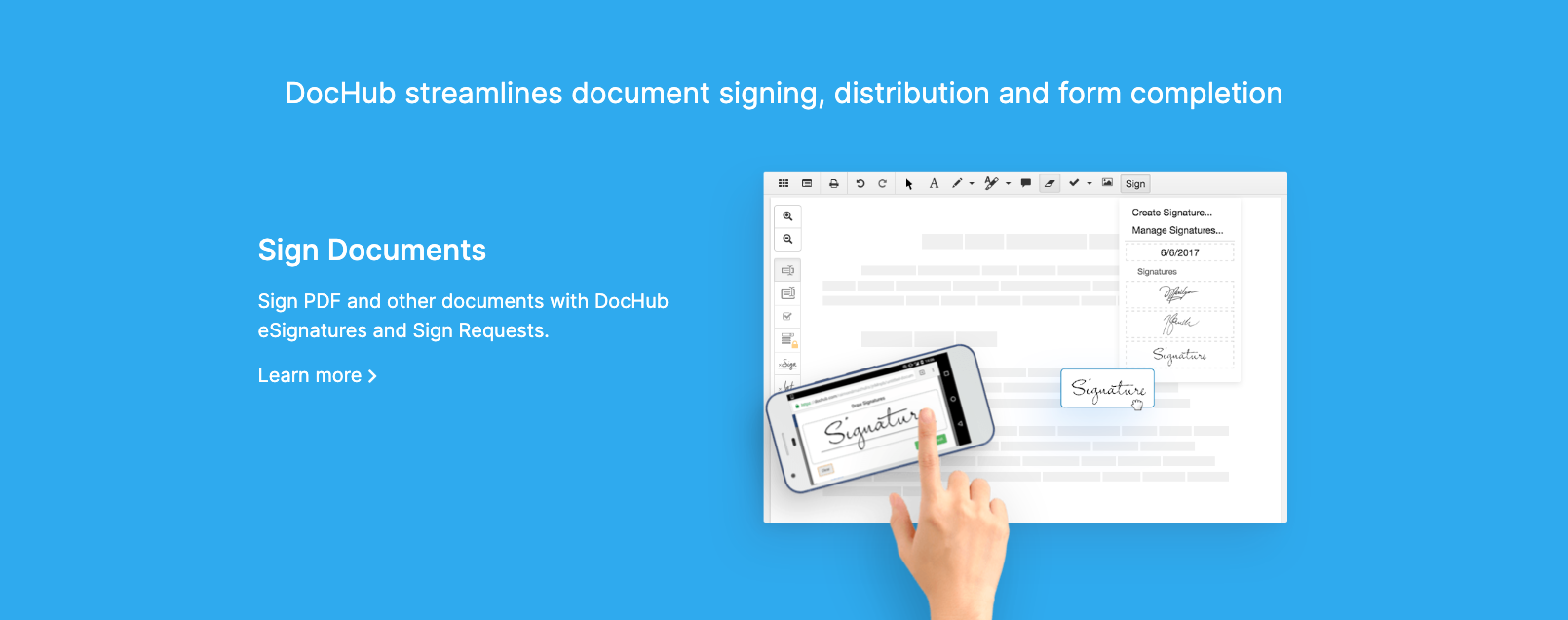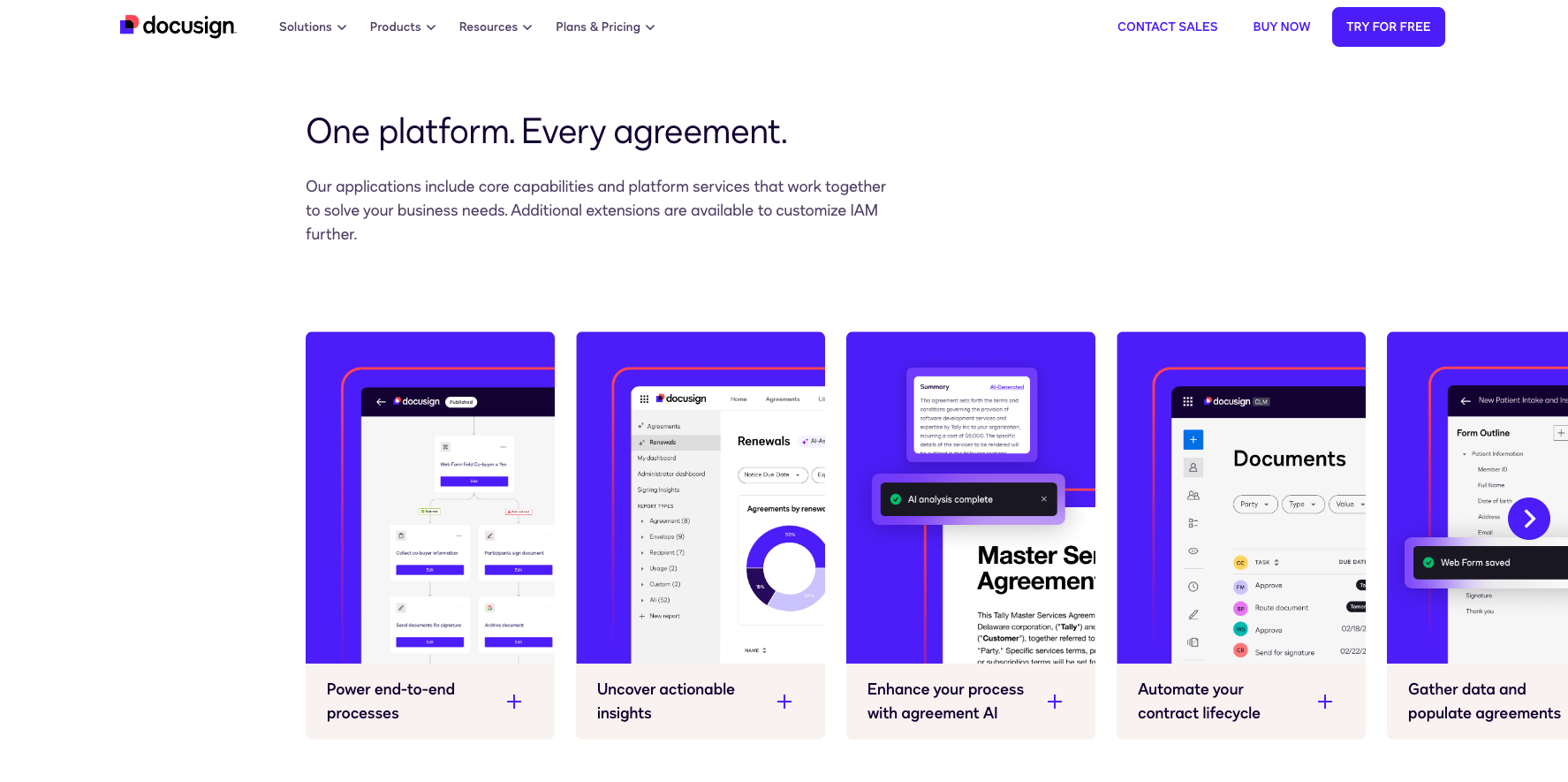If you’ve ever had to overnight a contract to a vendor or hire a courier service to track down a client for their signature, you know firsthand how valuable e-signature platforms are for organizations. Faxing, mailing, or sending a document via courier to obtain a signature can be expensive and time-consuming.
E-signature solutions help streamline processes, cut costs, improve collaboration and communication, and boost productivity — whether you work in real estate, healthcare, human resources, or just about any other industry.
But with so many e-signature tools to choose from, how do you know which is best for your organization? Let’s compare two popular solutions — DocHub vs Docusign — to help narrow down your list.
DocHub overview
DocHub, an online PDF editor and e-signature platform, prides itself on providing document digitization services that save thousands of trees each year. Launched in 2014, this e-signature solution prioritizes document security and customer satisfaction for its millions of active users.
Docusign overview
Docusign came on the market in 2003 as one of the first e-signature tools, and since then, it has transformed how people and businesses prepare, sign, and manage online documents. This platform integrates with 400-plus popular business apps and has millions of users in more than 180 countries.
If you are interested in exploring Docusign alternatives, you can check out our article that delves into various e-signature tools and their features.
DocHub vs Docusign: Key features
With DocHub, users can send, sign, and receive e-signature documents, build automated workflows to connect multiple signers, and even establish a legal audit trail that all signers can access. You can customize DocHub’s fillable, reusable PDF templates by modifying existing form fields (e.g., checkboxes, signature fields, etc.) or build new ones to match your brand and specific document needs.
While Docusign offers many of the same features as DocHub, it’s more comprehensive, so it has a few more capabilities. For example, both signers and senders can upload images on an e-signature document and draw free-form markups on them (e.g., to mark up a body image on a medical document or a property map on a mortgage agreement). Docusign also offers various ways to authenticate signers — by email, access code, SMS, and phone — to reduce the chances of fraud.
DocHub vs Docusign: Pricing
In terms of pricing, you only have two plan options with DocHub: Free or Pro ($10 per month). The Free plan gives you access to five e-signatures per month, three sign requests per month, and three emails per day, plus premium customization tools and priority tech support (which you have to pay for). The Pro plan, on the other hand, provides unlimited documents, e-signatures, and sign requests; 250 emails per day; 35 free fax pages per month; and premium tools for an extra cost.
Docusign offers two more plan options than DocHub: Personal ($10 per month), Standard ($25 per user per month), Business Pro ($40 per user per month), and custom plans (which require a call with a sales rep for pricing information). While some features are included in all four plans — like basic integrations, a real-time audit trail, and the ability to send and sign e-signature documents — others are only available to Business Pro and custom plan users. Those include the ability to collect payments, add a free-form drawing field, and send e-sign documents in bulk.
DocHub vs Docusign: Which is best?
As you can see, while DocHub and Docusign are similar in many ways, they also have some notable differences when it comes to plan options and versatility.
If you’re just beginning to collect e-signatures or own a small company, DocHub may be the better option for you. In addition to having access to a free plan, you also have the option to add on some premium features and only pay for what your business needs. Plus, at only $10 per month, upgrading to DocHub’s Pro plan is an effective, economical way to scale.
If your organization is on the larger side — with many moving parts and departments — you may prefer Docusign. It’s more robust than DocHub and jam-packed with hundreds of features and integrations to help you streamline your workflows and reduce your administrative burdens — whether you work in financial services, real estate, government, or another fast-paced industry.
A DocHub vs Docusign alternative: Jotform Sign
But before you choose DocHub or Docusign as your e-signature solution, consider another option: Jotform Sign.
With Jotform Sign, “e-signatures meet automation,” helping users of all coding backgrounds build e-signature documents, automate processes, and collect legally binding e-signatures.
This powerful platform includes a library of popular features to help you create, send, and track professional, reusable e-signature documents. You can use Jotform Sign’s drag-and-drop builder to add a wide variety of form field types (such as email address, initials, and date) into your online forms and PDFs.
Then, generate a public link for your newly created document and send it in an email or embed it on your website to collect e-signatures securely and quickly. You can set the order in which different people sign the document, send automated reminder emails, and store completed documents using the cloud storage provider of your choice — like Google Drive or Dropbox — for safekeeping. Jotform Sign is easy to use, comprehensive, and fully customizable.
Being able to quickly and easily create and send e-documents is a necessity these days. E-signature solutions help businesses of all sizes and industries cut costs, protect the environment, and boost productivity and profitability. Fortunately, whether you choose DocHub, Docusign, or Jotform Sign for collecting e-signatures, you’ll be more than equipped to handle all aspects of online document management.





































Send Comment: